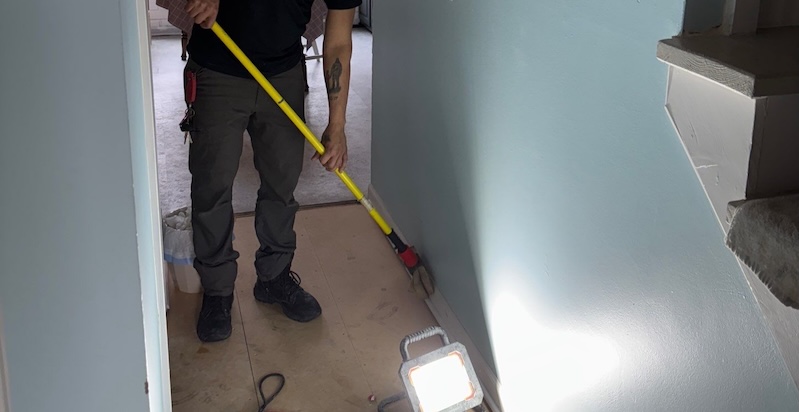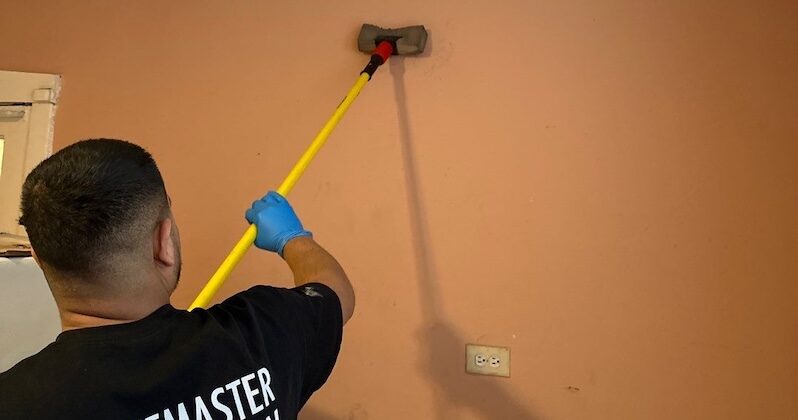The aftermath of a house fire goes beyond physical damage—it’s emotional and overwhelming.
Even after the flames are out, smoke damage leaves hidden dangers and lasting effects.
For over 15 years, ServiceMaster Restoration by Zaba has helped Chicago homeowners recover from fire damage.
Whether it’s a kitchen fire or full-structure loss, this guide covers what to expect from the smoke damage restoration process.
Key Takeaways
- After a fire, prioritize safety, contact your insurance provider and ServiceMaster by Zaba, and avoid DIY cleanup if the property isn’t safe.
- If it’s safe to begin cleanup, ventilate the area, inspect for smoke damage, sort belongings, and use proper gear and HEPA tools to clean soot and reduce odors.
- ServiceMaster by Zaba provides expert fire restoration in Chicago using professional equipment to remove smoke damage, rebuild property, and support your insurance claim.
How to Spot Smoke Damage in Your Home
Before you start cleaning, it’s important to know what smoke damage actually looks like.
In some cases, the damage is easy to spot.
But in others, especially when the fire was smoky or started in the kitchen, it can show up in places far from the source and be much harder to detect.
Keep an eye out for these signs:
- Black dust or oily film on surfaces
- Paint that looks yellowed or discolored
- Furniture or fabrics that smell like smoke
- Soot streaks or black marks on walls and ceilings
How to Clean Smoke Damage in Your Home: A Step-by-Step Guide

1. Gather Your Cleaning Supplies
Before you start scrubbing, make sure you have the right tools on hand:
- Thick rubber gloves
- An OSHA-rated respirator or disposable mask
- Safety goggles or protective eyewear
- Dry-cleaning sponges made for soot removal
- Trisodium phosphate (TSP) or a degreasing cleaner
- A large sponge for moisture absorption
- Two clean plastic buckets
- Cleaning cloths or old T-shirts
- A HEPA vacuum with hose and upholstery attachments
- Warm water
- Plastic drop cloths and a sturdy ladder
Set up your supplies in one place so they’re easy to reach as you work.
2. Take Proper Safety Precautions
Soot and residue often contain chemicals and fine particles that can irritate your skin, eyes, and lungs.
To stay safe:
- Always wear a mask while in the smoke-damaged area
- Open windows for ventilation before and during cleanup
- Avoid the area if you’re pregnant or have respiratory issues
- Keep children, older adults, and pets away from the space
- Work slowly and carefully—rushing can spread contaminants or worsen damage
If you’re ever unsure, pause and consider calling a certified restoration company to take over the job.
3. Inspect the Damage
Walk through your home and check every room for signs of smoke. You’ll likely see heavy soot buildup and black streaks, but also watch for grayish haze, light discoloration, and smoky odors—especially on ceilings, vents, and corners.
Sort items as you go: ruined, salvageable, and undamaged. Remove anything beyond repair and move salvageable items to a clean, dry space.
Pro tip: Take photos of damaged items before tossing them to help with your insurance claim.
4. Ventilate the Area
Open as many windows and doors as possible to bring in fresh air. Ventilation will help reduce strong smoke odors and push airborne particles out of the space.
Avoid running your HVAC system at this stage—this can pull soot into ductwork and spread it throughout your home.
5. Remove Loose Soot from the Floors
Wearing your gloves, goggles, and mask, use a HEPA vacuum to gently clean soot and debris from the floors.
Hold the vacuum slightly above the surface to avoid grinding particles deeper into the carpet or wood.
Use hose attachments to vacuum along baseboards and in corners where soot tends to settle.
6. Clean the Walls

Begin with a dry-cleaning sponge to lift soot off your walls. Wipe gently in straight, vertical strokes. Don’t scrub—this can smear the residue.
Cut away the used portion of the sponge as it blackens, or switch to a new one.
Next, mix a cleaning solution of warm water, mild soap, 4–6 tablespoons of TSP, and 1 cup of bleach per gallon of water. Test on a small area first to make sure it won’t discolor the surface.
Wearing rubber gloves, use a sponge to wipe walls from the bottom up to prevent streaking. Rinse each section with clean water and dry it with fresh towels.
Repeat the same process for the ceilings once the walls are done.
7. Wash Windows and Window Frames
Use a smoke-specific cleaner and soft cloths to wipe the glass and the surrounding frame.
Follow up with a degreaser to remove any oily residue left behind. Be thorough—smoke often settles along edges and in grooves.
8. Clean Furniture and Upholstery
Use a store-bought smoke damage cleaner that matches the type of material:
- Use wood-safe products for wooden furniture
- Wipe down plastic or metal with an all-purpose cleaner
- Vacuum upholstered items with a HEPA vacuum before using a fabric-safe cleaner
Work slowly to avoid pushing soot deeper into cushions or fibers.
9. Wash Textiles and Fabrics
Clothing, bedding, and other fabrics absorb smoke easily. Wash these items separately:
- Use detergent and bleach if the fabric allows
- For non-bleachable items, use detergent and a teaspoon of baking soda in cold water
- Heavily damaged items may benefit from TSP-based laundry products (follow label instructions carefully)
10. Remove Smoke Odor
Even after cleaning, odors can linger. To help absorb lingering smells:
- Place bowls of baking soda, white vinegar, or activated charcoal in each affected room
- Sprinkle baking soda on upholstery or carpets, let it sit for a few hours, then vacuum
- Consider professional odor removal services, like ozone treatment, if the smell persists
Why You Should Hire Certified Fire Restoration Experts

You can handle light cleanup, but full smoke restoration takes pros who clean, sanitize, and rebuild the right way.
Here’s what you get when you bring in a restoration team:
- Industrial-grade equipment for soot removal, odor control, and air purification
- Tear-out and reconstruction of drywall, flooring, and structural materials
- HVAC cleaning and sanitization to prevent recontamination
- Documentation and support for insurance claims
- Faster recovery with fewer long-term risks
At ServiceMaster by Zaba, we’ve restored hundreds of homes across the Chicago area.
We work quickly, thoroughly, and with compassion—helping families reclaim their space with confidence.
Dealing With Smoke Damage in Chicago? We’re Here For You
The damage caused by smoke is more than surface deep—it affects your home’s air quality, structure, and contents.
Act fast to avoid permanent damage and ensure a full recovery.
At ServiceMaster Restoration by Zaba, we bring over a decade of experience to every job with our fire and smoke damage restoration services.
Our certified technicians are available 24/7 to respond to smoke and fire damage throughout the Chicago area.
Don’t wait until minor damage becomes a major problem. Call us now at (773) 647-1985
FAQs
What should I do right after a fire?
Follow these steps to stay safe and begin the recovery process:
- Put safety first – Don’t re-enter the building until the fire department confirms it’s safe. Hidden hot spots, smoke, or structural damage can be dangerous.
- Call your insurance provider – Report the fire as soon as possible and start your claim. Take photos or videos of all visible damage and keep records of related expenses.
- Contact a certified restoration company – Reach out to professionals like ServiceMaster Restoration by Zaba. We offer 24/7 emergency fire damage response and help reduce long-term damage while guiding you through the insurance process.
- Avoid DIY cleanup – Smoke, soot, and water damage can be hazardous to your health and difficult to remove without proper equipment. Let trained professionals handle the cleanup safely and thoroughly.
What items can I save after smoke damage?
What you can save after smoke damage depends on how bad it is, the material, and how fast you start.
Non-porous items often clean up well, but porous or badly damaged ones may need replacing.
Items that can often be salvaged:
- Glassware and ceramics – Non-porous and easy to clean with proper solutions.
- Hardwood furniture – If not burned or warped, can often be cleaned and refinished.
- Metal fixtures and tools – Can be cleaned and polished unless corroded.
- Clothing and fabrics – If lightly exposed, washable with vinegar or baking soda pre-treatments.
- Electronics – May be restorable if professionally cleaned and not heat-damaged.
- Books, photos, and documents – Can sometimes be recovered using freeze-drying or vacuum-sealing techniques.
- Upholstery and drapes – Depending on the fabric and level of exposure, professional textile cleaning may be effective.
- Area rugs – Often cleanable if not heavily stained or soaked.
Items that are typically unsalvageable:
- Drywall and insulation – Absorb smoke particles deeply and often retain odor or moisture.
- Heavily soot-stained carpets and padding – Usually need to be removed due to deep contamination and potential mold.
- Mattresses and pillows – Absorb odors and particles deeply; cleaning is not usually effective.
- Composite or laminate flooring – Foam or fiber underlayers trap smoke and degrade quickly.
- Plastic materials – Often melt, warp, or release toxins when exposed to high heat or soot.
- Heavily discolored tile grout – Difficult to fully clean due to its porous nature.
- Wood furniture with bubbling or deep charring – Indicates structural damage that can’t be reversed.
- Curtains or textiles with set-in smoke odor – Especially those made of delicate or synthetic materials.
At ServiceMaster Restoration by Zaba, we provide full content packout, cleaning, and restoration services.
We carefully remove, inventory, and restore your belongings in a secure off-site facility to give you the best chance of recovery after smoke damage.
How fast should I start smoke damage cleanup?
Soot begins staining walls and ceilings within hours. After 24 to 48 hours, porous materials like drywall and carpet may suffer irreversible damage, and odors become much harder to remove.
Acting quickly—ideally within the first 24 hours—offers the best chance at salvaging contents and minimizing costs.
Can I clean smoke-damaged electronics or appliances myself?
No. Electronics exposed to smoke can be internally damaged even if they appear to work.
Fine soot particles may corrode circuits or cause long-term failure. It’s best to have electronics professionally assessed and cleaned.
What types of smoke damage are there?
There are four common types:
- Dry smoke from high-temperature fires, usually easier to clean.
- Wet smoke from smoldering fires, sticky and harder to remove.
- Protein smoke from cooking fires, often invisible but very odorous.
- Oil-based smoke from garages or industrial fires, extremely persistent.
Each type requires different cleaning methods, which is why professional assessment is so important.
What types of properties does ServiceMaster by Zaba serve for smoke damage restoration?
ServiceMaster by Zaba provides professional smoke and fire damage restoration for both residential and commercial properties throughout Chicago and the Suburbs.
Whether you’re a homeowner, property manager, or business owner, our certified team has the expertise and equipment to handle restoration projects of all sizes.
We serve:
- Single-family homes
- Apartments
- Condos
- Multi-unit residential buildings
- Restaurants and commercial kitchens
- Office buildings and retail spaces
- Schools, daycare centers
- Healthcare facilities
- Industrial and warehouse properties
- Government and municipal buildings
We understand the unique needs of each property type and provide customized restoration plans—including emergency board-up, structural repair, content packout, and odor removal—to help you recover quickly and safely. For immediate service, call (773) 647-1985.